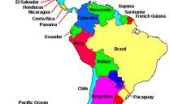Molly Minturn - My family is heartbroken to share that my father died in surgery on Monday, Feb. 10. It…
Africa: Environmental degradation
Written by Diana Thebaud Nicholson // August 5, 2011 // Africa, Agriculture & Food, Sustainable Development // Comments Off on Africa: Environmental degradation
Niger Delta oil damage needs decades, $1 billion to fix
The environmental damage from oil spills in the small Ogoniland region of the Niger Delta could cost $1 billion to clean up over the course of some 30 years, according to a UN report released Thursday. The report highlights the health risks for residents from spills traced back to oil giant Royal Dutch Shell, which financed the report, and acknowledges primary responsibility. The Wall Street Journal (tiered subscription model) (8/5)
4 August
Shell faces $410M payout over Nigeria oil spills
(FT via CNN) Royal Dutch Shell faces having to pay compensation of potentially more than £250m ($410m) after the Anglo-Dutch oil group admitted liability for two spills in Nigeria following a legal claim brought in the UK.
The agreement comes after a class-action lawsuit was brought in the High Court by the Bodo Community in the Niger Delta against Shell and its subsidiary, Shell Petroleum Development Company (SPDC).
2010
24 July
Oil Giant Fined for Shipping Sludge to Ivory Coast
(NYT) A Dutch court on Friday imposed the maximum fine of 1 million Euros, or $1.28 million, on the oil trading company Trafigura for illegally exporting highly toxic sludge that ended up dumped in Ivory Coast. The stinking waste was eventually linked to the deaths of 16 people and thousands of illnesses in 2006. Trafigura has denied wrongdoing, but in separate settlements it paid $200 million to the Ivory Coast for clean-up and $50 million to close to 30,000 victims and their families.
16 July
The World’s Ongoing Ecological Disasters
(Foreign Policy) While it’s probably still too soon to celebrate, BP appears to finally be getting the oil spill in the Gulf of Mexico under control. But many of the world’s greatest environmental catastrophes continue, with no end in sight.
The Deepwater Horizon incident may have been the worst oil spill in U.S. history, but it pales in comparison to the ongoing catastrophe that has afflicted Nigeria’s Niger River Delta over the last five decades. As many as 546 million gallons of oil are believed to have spilled since oil exploration began in this region — the equivalent of an Exxon Valdez spill every year.
There are around 2,000 official spill sites in the region, some of them decades old.
16 June
Adam Nossiter: Far From Gulf, a Spill Scourge 5 Decades Old
(NYT) BODO, Nigeria — Big oil spills are no longer news in this vast, tropical land. The Niger Delta, where the wealth underground is out of all proportion with the poverty on the surface, has endured the equivalent of the Exxon Valdez spill every year for 50 years by some estimates. The oil pours out nearly every week, and some swamps are long since lifeless.
30 May
Nigeria’s agony dwarfs the Gulf oil spill. The US and Europe ignore it
(The Guardian) The Deepwater Horizon disaster caused headlines around the world, yet the people who live in the Niger delta have had to live with environmental catastrophes for decades
Can Africa’s climate challenges spur growth?
Efforts to turn Africa’s climate-change challenges into opportunities for development through the cultivation of biofuel crops such as jatropha are growing. Supporters say such endeavors bring economic gains and provide access to mitigation strategies, while opponents argue increased poverty and poor resource management often accompany projects. The Globe and Mail (Toronto) (5/25)
Africa’s lake Tanganyika warming fast, life dying
(Reuters) – Africa’s lake Tanganyika has heated up sharply over the past 90 years and is now warmer than at any time for at least 1,500 years, a scientific paper said on Sunday, adding that fish and wildlife are threatened.
Lead scientist on the project Jessica Tierney told Reuters the sharp rise in temperature coincided with rises in human emissions of greenhouse gases seen in the past century, so the study added to evidence that emissions are warming the planet.
12 May
PLATFORM reveals Congo oil contracts that threaten resource wars and $10 billion rip-off
Tullow & British Embassy push disputed deal that could cut Congo’s revenues by $10 billion
The Production Sharing Agreements (PSAs) are accompanied by a legal analysis, ”A Lake of Oil – Congo’s controversial contracts compromise rights, environment & safety”, published in English and French by PLATFORM in partnership with the African Institute for Energy Governance (Afiego).
In ”A Lake of Oil”, PLATFORM also raises concerns about:
* Co-operation between oil companies and military groups and the likelihood of escalating resource-driven war in eastern Congo.
* The legal rights granted to flare natural gas
* The complete absence of penalties for environmental damage
* The ‘stabilisation clause’, which will restrict DRC’s ability to improve its environmental protection and human rights standards in the future
2009
28 December
Wall of trees proposed to stop spread of Sahara
At the UN climate talks in Copenhagen, Senegalese officials revealed a dramatic plan to curb the southward creep of the Saharan desert: a “Great Green Wall” of trees stretching from Senegal to Djibouti. Trees represent a strong defense against the growth of deserts, which threaten to consume as much as two-thirds of African farmland by 2025. The “Great Green Wall” was first proposed by Nigerian President Olusegun Obasanjo in 2005 and approved by the African Union in 2007. National Geographic News (12/28)
A history of African mega-droughts
The first study conducted on annual droughts over a period of millenniums reveals catastrophic droughts have devastated the sub-Saharan Africa, one of the poorest regions in the world, sometimes for centuries at a time. The steady procession of severe annual droughts is linked to an ocean phenomenon called the Atlantic multidecadal oscillation. The New York Times (4/16)
21 February
Pristine African Park Faces Development
IVINDO NATIONAL PARK, Gabon — The forest here seems to go on forever, interrupted only by the broad ribbons of its rivers. Deep inside, some of the world’s rarest creatures cavort in one of the most pristine patches of rain forest on earth, a direct but accidental result of Gabon’s reliance on one of the filthiest fossil fuels: crude oil. In forests as old as the last ice age, an iron ore mining venture backed by Gabon’s president is threatening to destroy a huge waterfall known as Kongou Falls by damming the Ivindo River to power a mine and its railway.
We first heard about the remarkable Megatransect during a talk by Klaus Liedtke, the Director of National Geographic, Deutschland. We were totally captivated and rushed home to explore the stories on the National Geographic website. It seems, according to Mr. Liedtke’s vivid – and entertaining – account, that Michael Fay single-handedly convinced President Bongo to establish the vast Ivindo Park. Background to this story: (National Geographic) Gabon to Create Huge Park System for Wildlife ; Congo Trekking With the World’s Most Adventurous Explorer
2008
14 August
African firms start to take action on climate change
“The environment is not being taken very seriously in most of the emerging markets, because we haven’t started feeling the pressure yet. But it has got to be addressed and it is up to us corporates to lead that.” Barclays Bank Kenya chief executive Adan Mohamed.
Environmental Change Re-Draws Atlas of Africa
Glacial Retreat to Rapid Urbanization Chronicled in Landmark Satellite Report to Africa’s Environment Ministers
Johannesburg/Nairobi/London, 10 June 2008 – Africa’s rapidly changing environmental landscape, from the disappearance of glaciers in Uganda’s Rwenzori Mountains to the loss of Cape Town’s unique “fynbos” vegetation, is presented today to the African Ministerial Conference on the Environment (AMCEN).
The Atlas, compiled on behalf of the ministers by the UN Environment Programme(UNEP), underlines how development choices, population growth, climate change and, in some cases, conflicts are shaping and impacting the natural and nature-based assets of the region.
11 June
Nature laid waste: The destruction of Africa
The massive scale of environmental devastation across the continent has been fully revealed for the first time in an atlas compiled by UN geographers. Michael McCarthy reports
Independent Graphics
(The Independent) It was long shrouded in mystery, called “the Dark Continent” by Europeans in awe of its massive size and impenetrable depths. Then its wondrous natural riches were revealed to the world. Now a third image of Africa and its environment is being laid before us – one of destruction on a vast and disturbing scale.
Using “before and after” satellite photos, taken in all 53 countries, UN geographers have constructed an African atlas of environmental change over the past four decades – the vast majority of it for the worse.
In nearly 400 pages of dramatic pictures, disappearing forests, shrinking lakes, vanishing glaciers and degraded landscapes are brought together for the first time, providing a deeply disturbing portfolio of devastation.
The atlas, compiled by the United Nations Environment Programme (UNEP) at the request of African environment ministers, and launched yesterday simultaneously in Johannesburg and London, underlines how extensively development choices, population growth, regional conflicts and climate change are impacting on the natural world and the nature-based assets of the continent.
The satellite photos, some of them spanning a 35-year period, offer striking snapshots of environmental transformation in every country.
The purpose of the atlas is to inspire African governments to improve their records as environmental custodians, and as such, its language and tone are studiously neutral, generally referring to environmental “change” rather than destruction. But although there are some examples given of change for the better, the vast majority of the case studies are of large-scale environmental degradation, and the atlas compilers freely accept that this represents the true picture.
They write of “the swell of grey-coloured cities over a once-green countryside; protected areas shrinking as farms encroach upon their boundaries; the tracks of road networks through forests; pollutants that drift over borders of neighbouring countries; the erosion of deltas; refugee settlements scattered across the continent causing further pressure on the environment; and shrinking mountain glaciers.”
For its visual impact, the atlas takes advantage of the latest space technology and Earth observation science, including the 36-year-old legacy of the US Landsat satellite programme, demonstrating the potential of satellite data in monitoring ecosystems and changes to them.
The “before and after” shots show vividly just how vast the changes have been, not only since the first Landsat satellite in 1972, but on much shorter timescales. Deforestation is shown not only as mass forest disappearance in countries such as Rwanda, but also as the insidious spread of logging roads through once entirely untouched rainforests in countries such as the Democratic Republic of the Congo, and the replacement of natural forest by bright green rubber and palm plantations in Cameroon.
Urban spread is illustrated not only by the dramatic expansion of the Senegalese capital Dakar over the past half century, from a small urban centre at the tip of the Cape Verde peninsula, to a metropolitan area with 2.5 million people spread over the entire peninsula, but by the rapid development of a small town like Bangassou in the Central Africa republic, now beginning to affect the nearby forest.
Shrinkage of mountain glaciers is shown only in the well-known case of Mount Kilimanjaro, but also in the disappearing glaciers in Uganda’s Rwenzori mountains, which decreased by 50 per cent between 1987 and 2003. And to the well-known cases of the drying up of Lake Chad, and falling water levels in Lake Victoria, the atlas adds new cases of disappearing water bodies like the drying up of Lake Faguibine in Mali, as well as many examples of desertification, unsustainable large-scale irrigation and degraded coastal areas.
Put it all together and you have a picture that is hard to credit, so enormous is the destruction. Statistically, the atlas finds that deforestation is a major concern in no fewer than 35 African countries, including the Democratic Republic of the Congo, Rwanda, Nigeria and Malawi, among others. Africa is losing more than four million hectares of forest every year – twice the world’s average deforestation rate.
That problem is closely followed in significance by major loss of biodiversity [wildlife] which is occurring in 34 countries, such as Angola, Ethiopia, Gabon and Mali. Land degradation is similarly a major worry for 32 countries, including Cameroon, Eritrea and Ghana, with some areas across the continent said to be losing more than 50 metric tonnes of soil per hectare per year.
The atlas shows that erosion, as well as chemical and physical damage, have degraded about 65 per cent of the continent’s farmlands. In addition, slash-and-burn agriculture is adding to the number of wildfires which are naturally caused by Africa’s high prevalence of lightning.
Rapidly rising populations account for one of the principal pressures on the natural resource base. Between 2000 and 2005, the atlas says, Africa’s population grew by 2.32 per cent annually – nearly double the global rate of 1.24 per cent per year. Twenty of the 30 fastest growing countries in the world are in Africa, including Liberia, which has the highest annual growth rate – 4.8 per cent – of any country in the world. In the next half century Africa will have twice the population growth rate of any other region. This means that more and more land must be devoted to agriculture, but as the amount of available land is limited, the amount available per person is swiftly shrinking. The atlas points out that in 1950 there were 13.5 hectares of land per person in Africa, but by 1990 this had shrunk to 4.7 hectares per person and by 2005 to 3.2 hectares per person – while on present population growth estimates, by 2050 the amount will be 1.5 hectares per person.
And now, it says, climate change is emerging as a driving force behind many of these problems and is likely to intensify the “already dramatic transformations” taking place. Although Africa’s 965 million people produce only 4 per cent of the world’s total greenhouse gas emissions, they are likely to suffer disproportionately from the consequences of global warming, not least because African nations’ ability to adapt to climate change is relatively low.
One of the key points the atlas makes is that environmental degradation is likely to have a higher human cost in Africa than in other regions, as people on the continent live in closer relation to the natural world than elsewhere: they are often directly dependent on the environment.
It was for African governments themselves to address the problem, said Marion Cheatle, chief of UNEP’s Early Warning Branch, who introduced the atlas in London. “In many places you have a problem of policies being enforced. Not that policies and legislative instruments [to protect the African environment] are not in place, but very often they’re only on paper, and they don’t have the management to follow that really should be in place.”
2006
9 September
Five dead, 6,000 Poisoned In Ivory Coast Toxic Waste Disaster
(Terra Daily) Five people have died and more than 6,000 people have been poisoned by toxic chemicals that were dumped last month in open-air junk yards in Abidjan, Ivory Coast’s health ministry said Sunday.
A total of 538 tonnes of liquid waste was unloaded in August from a Panamanian-registered ship, according the port’s manifest sheet, and dumped onto about 10 open-air sites in the commercial capital Abidjan, a city of four million people.
Environmental pressure group Greenpeace said the sludge was made up of 400 tonnes of oil refining waste, rich in organic matter and poisonous elements. The latter include hydrogen sulphide and organochloride, which cause nausea, rashes, fainting, diarrhoea and headaches.



